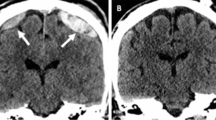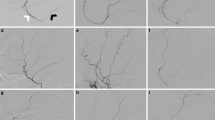Abstract
Background
The primary aim of chronic subdural haematoma (CSDH) treatment is to relieve pressure to improve neurological symptoms. The secondary aim is to avoid recurrence. The blood supply from the middle meningeal artery (MMA) to the haematoma membranes has recently become a research target, to enhance our understanding of the processes leading to growth and re-growth of a CSDH. Several studies indicate that endovascular embolization of the MMA (eMMA) reduces recurrence rates, but this effect must be confirmed in a randomized controlled setting. Endovascular embolization is an advanced and costly procedure carrying a significant risk of embolism in the elderly. The aim of this study was to assess anatomical and technical aspects of surgical occlusion of the MMA (soMMA) via a single same-procedure burr hole, as an alternative to eMMA.
Method
Technical aspects of soMMA were assessed using cadaver head dissection. MMA anatomy was examined by mapping the branching pattern and distribution of MMA in dry skulls, and CSDH position was investigated by analysis of computed tomography (CT) of CSDHs. Finally, we evaluated the possibility of CT-guided navigation to mark the branching point of the anterior MMA division on the skin.
Results
We established anatomical landmarks to locate the MMA and found that particularly the anterior MMA branch can be occluded through a single burr hole at the pterion during the same procedure as haematoma decompression. CT of 1454 CSDHs in 1162 patients showed that the CSDH was anteriorly located in 57.5% compared with posteriorly in only 3%. This correlated with the anterior branch of the MMA being dominant in 58% of dry skull samples examined. We further confirmed that the MMA can be localized by neuronavigation as an alternative to using anatomical landmarks and average measurements.
Conclusion
A CSDH is mainly anteriorly located and supposedly primarily supplied by the anterior MMA branch. In a simulated setting, soMMA can be performed during the same procedure as haematoma decompression. A few reservations notwithstanding, we find that soMMA may be a viable alternative to eMMA in most CSDH cases and that soMMA should be further evaluated in a clinical setting.






Similar content being viewed by others
References
Andersen-Ranberg NC, Poulsen FR, Bergholt B, Hundsholt T, Fugleholm K (2017) Bilateral chronic subdural hematoma: unilateral or bilateral drainage? J Neurosurg 126(6):1905–1911. https://doi.org/10.3171/2016.4.Jns152642
Bikmaz K, Iplikcioglu C, Dinc C, Arslan M (2006) Treatment of chronic subdural hematomas by clipping of arteria meningia media. Skull Base 16(S 1):A024. https://doi.org/10.1055/s-2006-958291
Dandridge NP (1895) Rose’s operation for trigeminal neuralgia. Boston Med Surg J 132:397–399. https://doi.org/10.1056/NEJM189504251321701
Haldrup M, Ketharanathan B, Bergholt B (2020) Embolization of the middle meningeal artery in patients with chronic subdural hematoma-a systematic review and meta-analysis. Acta Neurochir 162(4):777–784. https://doi.org/10.1007/s00701-020-04266-0
Kang J, Whang K, Oh JW (2015) Middle meningeal artery embolization in recurrent chronic subdural hematoma combined with arachnoid cyst. Korean J Neurotrauma 11(2):187–190. https://doi.org/10.13004/kjnt.2015.11.2.187
Kim E (2017) Embolization therapy for refractory hemorrhage in patients with chronic subdural hematomas. World Neurosurg 101:520–527. https://doi.org/10.1016/j.wneu.2017.02.070
Link TW, Boddu S, Paine SM, Kamel H, Knopman J (2019) Middle meningeal artery embolization for chronic subdural hematoma: a series of 60 cases. Neurosurgery 85(6):801–807. https://doi.org/10.1093/neuros/nyy521
Nagahori T, Nishijima M, Takaku A (1993) Histological study of the outer membrane of chronic subdural hematoma: possible mechanism for expansion of hematoma cavity. No Shinkei Geka 21(8):697–701
Plummer SC (1896) III. Research on the surgical anatomy of the middle meningeal artery. Ann Surg 23(5):540–572. https://doi.org/10.1097/00000658-189601000-00100
Tanaka T, Kaimori M (1999) Histological study of vascular structure between the dura mater and the outer membrane in chronic subdural hematoma in an adult. No Shinkei Geka 27(5):431–436
Acknowledgements
We thank Professor Jørgen Tranum Jensen and Chief Technician Johnny Grandt, The Panum Institute, Department of Anatomy, for lending us dry skulls for examination and for specimens, facilities and help with dissection. We thank Professor Annemarie Brüel and her team at the University of Aarhus for providing injected specimen and facilities for dissection.
Author information
Authors and Affiliations
Corresponding author
Ethics declarations
Ethics approval and consent to participate
This article does not contain any studies with human participants performed by any of the authors. For this type of study, formal consent is not required.
Conflict of interest
All authors certify that they have no affiliations with or involvement in any organization or entity with any financial interest (such as honoraria; educational grants; participation in speakers’ bureaus; membership, employment, consultancies, stock ownership, or other equity interest; and expert testimony or patent-licencing arrangements), or non-financial interest (such as personal or professional relationships, affiliations, knowledge or beliefs) in the subject matter or materials discussed in this manuscript.
Additional information
Comments
Chronic Subdural Hematoma (CSDH) is one of the most frequent neurosurgical diagnosis. Nevertheless, the optimal treatment regimen is yet to be defined. Middle meningeal artery (MMA) has recently become a promising new target in the treatment of CSDH, and while several reports exist on the potential value of MMA embolization (eMMA), reports on the potential benefit of surgical occlusion (soMMA) are lacking. I commend the authors for this technical study establishing anatomical landmarks, technical equipment and surgical approach needed in order to localize and occlude the anterior MMA branch in CSDH, assuring necessary know how for future studies aimed at evaluating the potential clinical benefit of soMMA. Further, since the mechanism-of-action is different between eMMA and soMMA, future studies will be needed to evaluate potential advantages/disadvantages eMMA versus soMMA.
Jiri BartekStockholm, Sweden
Publisher’s note
Springer Nature remains neutral with regard to jurisdictional claims in published maps and institutional affiliations.
This article is part of the Topical Collection on Neurosurgical technique evaluation
Rights and permissions
About this article
Cite this article
Haldrup, M., Munyemana, P., Ma’aya, A. et al. Surgical occlusion of middle meningeal artery in treatment of chronic subdural haematoma: anatomical and technical considerations. Acta Neurochir 163, 1075–1081 (2021). https://doi.org/10.1007/s00701-021-04754-x
Received:
Accepted:
Published:
Issue Date:
DOI: https://doi.org/10.1007/s00701-021-04754-x




